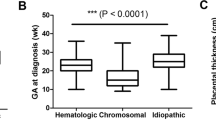Abstract
Objective:
To determine the prevalence, risk factors and diseases associated with isolated lenticulostriate vasculopathy (LSV) among preterm infants.
Study Design:
Medical records of 84 preterm infants (gestational age (GA) 25 to 34 weeks) with isolated LSV in a case–control retrospective study over a period of 6.5 years were reviewed and compared with matched control infants. LSV was defined as ‘early’ if it was documented in head ultrasound (HUS) before or on the fifth day of life and ‘late’ if it was not present in the first HUS and recorded later during neonatal hospitalization.
Results:
A 3.9% prevalence of LSV was recorded among preterm infants (GA⩽34 weeks). Study and control groups were similar for all maternal parameters, neonatal outcomes and length of hospitalization. Infants with late LSV had more neonatal complications than control infants and were born with younger GA and lower birth weight in comparison to infants with early LSV. More infants with late LSV needed mechanical ventilation, were diagnosed with bronchopulmonary dysplasia and were hospitalized longer in comparison to infants with early LSV. Urine cytomegalovirus was negative in the entire study group.
Conclusions:
No risk factors or specific associated morbidities were identified among preterm infants with early isolated LSV. Infants with late isolated LSV were younger and had overall increased associated morbidities. Long-term outcome studies are needed to determine LSV impact.
This is a preview of subscription content, access via your institution
Access options
Subscribe to this journal
Receive 12 print issues and online access
$259.00 per year
only $21.58 per issue
Buy this article
- Purchase on Springer Link
- Instant access to full article PDF
Prices may be subject to local taxes which are calculated during checkout
Similar content being viewed by others
References
Mittendorf R, Kuban K, Pryde PG, Gianopoulos JG, Yousefzadeh D . Antenatal risk factors associated with the development of lenticulostriate vasculopathy (LSV) in neonates. J Perinatol 2005; 25 (2): 101–107.
Coley BD, Rusin JA, Boue DR . Importance of hypoxic/ischemic conditions in the development of cerebral lenticulostriate vasculopathy. Pediatr Radiol 2000; 30 (12): 846–855.
Leijser LM, Steggerda SJ, de Bruïne FT, van Zuijlen A, van Steenis A, Walther FJ et al. Lenticulostriate vasculopathy in very preterm infants. Arch Dis Child Fetal Neonatal Ed 2010; 95 (1): F42–F46.
Makhoul IR, Eisenstein I, Sujov P, Soudack M, Smolkin T, Tamir A et al. Neonatal lenticulostriate vasculopathy: further characterisation. Arch Dis Child Fetal Neonatal Ed 2003; 88 (5): F410–F414.
El Ayoubi M, de Bethmann O, Monset-Couchard M . Lenticulostriate echogenic vessels: clinical and sonographic study of 70 neonatal cases. Pediatr Radiol 2003; 33 (10): 697–703.
Hemachandra AH, Oravec D, Collin M, Tafari N, Mhanna MJ . Early and late postnatal identification of isolated lenticulostriate vasculopathy in preterm infants: associated findings. J Perinatol 2003; 23 (1): 20–23.
Rumack CM, Drose JA. Neonatal and infant brain imaging. In: Rumack CM, Wilson SR, Charboneau JW (eds). Perinatal Neuroradiology. Elsevier Mosby: St. Louis, MO, USA, 2005, p 1624.
de Jong EP, Lopriore E, Vossen AC, Steggerda SJ, Te Pas AB, Kroes AC et al. Is routine TORCH screening warranted in neonates with lenticulostriate vasculopathy? Neonatology 2010; 97 (3): 274–278.
Teele RL, Hernanz-Schulman M, Sotrel A . Echogenic vasculature in the basal ganglia of neonates: a sonographic sign of vasculopathy. Radiology 1988; 169 (2): 423–427.
Wang HS, Kuo MF . Sonographic lenticulostriate vasculopathy in infancy with tic and other neuropsychiatric disorders developed after 7 to 9 years of follow-up. Brain Dev 2003; 25 (Suppl 1): S43–S47.
Kashman N, Kramer U, Stavorovsky Z, Shefer-Kaufmann N, Harel S, Mimouni FB et al. Prognostic significance of hyperechogenic lesions in the basal ganglia and thalamus in neonates. J Child Neurol 2001; 16 (8): 591–594.
Wang HS, Kuo MF, Chang TC . Sonographic lenticulostriate vasculopathy in infants: some associations and a hypothesis. AJNR Am J Neuroradiol 1995; 16 (1): 97–102.
Author information
Authors and Affiliations
Corresponding author
Ethics declarations
Competing interests
The authors declare no conflict of interest.
Rights and permissions
About this article
Cite this article
Maayan-Metzger, A., Leibovitch, L., Schushan-Eisen, I. et al. Risk factors and associated diseases among preterm infants with isolated lenticulostriate vasculopathy. J Perinatol 36, 775–778 (2016). https://doi.org/10.1038/jp.2016.67
Received:
Revised:
Accepted:
Published:
Issue Date:
DOI: https://doi.org/10.1038/jp.2016.67
This article is cited by
-
Lenticulostriate vasculopathy in preterm infants: a new classification, clinical associations and neurodevelopmental outcome
Journal of Perinatology (2018)



